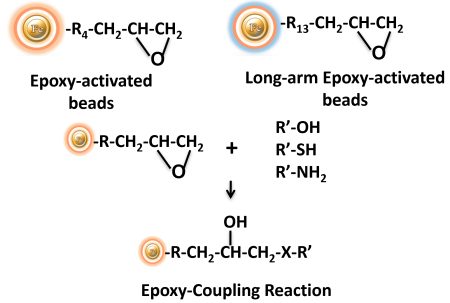- +1 858 909 0079
- +1 858 909 0057
- [email protected]
- +1 858 909 0079
- [email protected]

Products
Cat. No.
Product Name
Unit Size
Order
FC109
BcMag™ Epoxy-Activated Magnetic Beads Conjugation Buffer Kit
Kit Components
– 10x coupling Buffer: 25 ml 1M Sodium carbonate buffer, pH 7.0
– Blocking Buffer: 25 ml 1 M Ethanolamine, pH 9
– 10 x Wash Buffer: 24 ml 10x PBS, pH 7.2
Each
Specification
Composition
Magnetic beads are grafted with a high density of epoxy groups
Number of Beads
~ 1.68 x 109 beads/mg (1μm beads)
~ 5 x 107 beads /mg (5μm beads)
Stability
Short Term (<1 hour): pH 3-11; Long-Term: pH 4-10
Temperature: 4°C -140°C; Most organic solvents
Magnetization
~40-45 EMU/g
Type of Magnetization
Superparamagnetic
Formulation
Lyophilized Powder
Functional Group Density
1μm Magnetic Beads
~250 μmole / g of Beads
5μm Magnetic Beads
~195 μmole / g of Beads
1μm Long-Arm Magnetic Beads
~200 μmole / g of Beads
5μm Long-Arm Magnetic Beads
~172 μmole / g of Beads
Storage
Ship at room temperature. Store 4°C upon receipt.
BcMag™ Epoxy-Activated Magnetic Beads are magnetic beads that have been pre-treated with a coating of high-density epoxy functional groups on their surface. This coating enables the beads to covalently attach to ligands containing amine, sulfhydryl, or hydroxyl groups, as shown in Figure below. The hydrophilic surface of the beads also ensures that they have low levels of nonspecific adsorption, making them easy to handle in a variety of buffer solutions. These beads are particularly well-suited for conjugating large proteins. If you are looking to conjugate small peptides, we recommend using BcMag™ Long-arm Epoxy-Activated Magnetic Beads, which have a longer hydrophilic linker that can help to reduce steric hindrance.

Conjugation Protocol
Note:
●
The following protocol is an example of coupling amine-containing ligands to BcMag™ Epoxy-activated magnetic beads.
●
This protocol can be scaled up as needed. We strongly recommended titration to optimize the number of beads used for each application.
●
Avoid tris or other buffers containing primary amines or other nucleophiles because these will compete with the intended coupling reaction. But the wash or storage buffers can contain amino.
●
We recommended performing titration to optimize the quantity of beads used for each application. This protocol can be scaled up and down accordingly.
Materials Required
1.
Coupling Buffer: 0.1 M sodium carbonate buffer or 0.1 M sodium phosphate, pH 8.5-10
Note: Water-insoluble ligands can be conjugated in 50% organic solvent (dioxane, dimethylformamide). Coupling Hydroxyl-, Amine- and Thiol-containing ligands are preferred at pH 10, pH 9, and pH 7.5-8.5, respectively.
2.
Blocking Buffer: 1 M ethanolamine pH 9.0
3.
Wash buffer: PBS, pH 7.4
4.
Magnetic Rack (for manual operation)
Based on sample volume, the user can choose one of the following Magnetic Racks:
– BcMag™ Magnetic Rack-2 for holding two individual 1.5 ml centrifuge tubes (Cat. No. MS-01);
– BcMag™ Magnetic Rack-6 for holding six individual 1.5 ml centrifuge tubes (Cat. No. MS-02);
– BcMag™ Magnetic Rack-24 for holding twenty-four individual 1.5-2.0 ml centrifuge tubes (Cat. No. MS-03);
– BcMag™ Magnetic Rack-50 for holding one 50 ml centrifuge tube, one 15 ml centrifuge tube, and four individual 1.5 ml centrifuge tubes (Cat. No. MS-04);
– BcMag™ Magnetic Rack-96 for holding a 96 ELISA plate or PCR plate (Cat. No. MS-05).
A.
Magnetic Beads Preparation
1.
Combine 30 mg magnetic beads with 1 ml coupling buffer in a centrifuge tube and mix well.
2.
Place the tube on the magnetic rack for 1-3 minutes. Remove the supernatant while the tube remains on the rack. Remove the tube from the rack and resuspend the beads with 1 ml coupling buffer by vortex for 30 seconds.
3.
Place the tube on the magnetic rack for 1-3 minutes. Remove the supernatant, and the washed beads are ready for coupling.
B.
Ligand preparation
1.
Dissolve 0.5-10 mg protein, or 200 μmoles peptides, or dilute the appropriate amount of protein and peptide in a 1 ml coupling buffer.
Note:
●
Coupling efficiencies to epoxy-activated magnetic beads vary from ligand to ligand. The user should empirically optimize the concentration of the ligand. The user should empirically optimize the concentration of the ligand. We recommend 0.5-10 mg/m for protein or 200 μmoles per ml for small peptides.
●
If samples have already been suspended in other buffers, dilute samples with a 4-fold volume of coupling buffer or desalt or dialyze to buffer-exchange into coupling buffer.
C.
Coupling
1.
Add the protein solution to the washed beads. Resuspend the magnetic beads and incubate the reaction with continuous rotation.
Note:
●
Immobilize amine-containing ligands such as proteins at 25°C from 15-48 hours. However, if the ligand is very sensitive to temperature, it can be conjugated at 4°C for 48-72 hours.
●
Conjugate peptides or hydroxyl-containing ligands such as carbohydrates from 25-75°C for 4-15 hours.
●
For thiol-containing ligands, perform conjugation at 25-75°C for 4-15 hours.
2.
Wash beads with 5ml PBS buffer three times.
3.
Add 5ml blocking buffer to the beads and incubate at 4°C for at least 4 hours or overnight.
4.
Wash beads with 5 ml PBS three times.
5.
Resuspend the beads in PBS buffer with 0.01% azide (w/v) to desired concentration and store at 4°C until use. Do not Freeze.
Magnetic Beads Make Things Simple